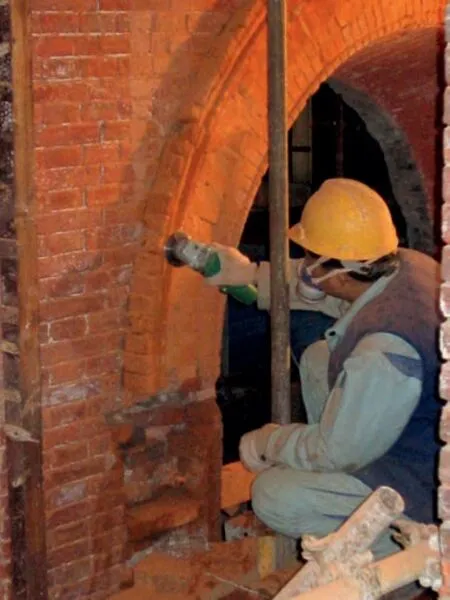外滩轮船招商总局大楼修复工程设计,上海
设计主持:常青,华耘
设计顾问:罗小未
方案设计:常青,华耘,王红军,王方
合作设计:张鹏,王云峰,丰雷
结构设计:熊本松
设备设计:杜文华,蔡龙俊,肖辉,
王铭
室内设计:许乙泓,左琰,郑鸣,
蒲仪军
结构形式:砖木结构
建筑面积:1460m²
建筑高度:17.86m
设计时间:2001
竣工时间:2004
摄影:汤众,张鹏,项目工作组
Principal Architects: CHANG Qing,HUA Yun
Consultant: LUO Xiaowei
Schematic Design: CHANG Qing,
HUA Yun, WANG Hongjun, WANG Fang
Cooperative Architects: ZHANG Peng,
WANG Yunfeng, FENG Lei
Structural Engineer: XIONG Bensong
Mechanical Engineers: DU Wenhua,
CAI Longjun, XIAO Hui, WANG Ming
Interior Design: XU Yihong, ZUO Yan,
ZHENG Ming, PU Yijun
Structure: Brick and timber structure
Floor Area: 1460 m²
Building Height: 17.86 m
Design Time: 2001
Completion Time: 2004
Photos: TANG Zhong, ZHANG Peng,
Project team
外滩九号“轮船招商总局大楼”建于1901 年,是在原旗昌洋行临江花园的基址上建造的,是外滩建筑群中唯一一座新古典风格的外廊式建筑。原建筑由英国玛礼逊洋行设计。建筑主体为3 层砖、石、木、钢4 种材料混用的结构。百年沧桑,物是形非,包括南北两翼山花的整个坡顶屋面被拆除,新古典柱式构成的敞廊被简陋厂房般的玻璃面钢窗封死,红砖墙被水泥砂浆抹平。在建成100 年后,2001 年常青教授在主持“外滩源”立项规划和概念设计的同时,领衔对这一外滩建筑做了保护再生设计。
(1)外观复原设计
去除外立面柱间的后加钢框玻璃窗,拆除柱廊间后加的隔墙,完全恢复历史上敞开的柱廊。以分块切割、剔除的方法去掉外墙表面的水泥砂浆,使原红色清水砖墙重新裸露出来,再以引进德国修复砖墙的雷玛仕技术进行修复设计,再现东立面竖三段构图,复原其南北两端的山花屋面。
(2)屋顶山花复原
对建筑坡屋顶和山花外轮廓进行严格复原,使坡度、质地和色泽,以及山花图案的式样、疏密、深浅等布局及材质关系上尽量与历史图像完全一致 (偏绿的青石)。山花下的石雕檐额也按原样予以恢复。
(3)内部整饬设计
其一为结构加固,按原柱网位置重做桩基础和梁柱,增加100 根固体桩基。附体结构状况尚好,故将原木梁密肋结构楼层予以保留和加固处理;其二为空间再生,入口后加的简陋狭长走廊改为外方内圆的门厅;利用外部边角空间设计了侧向小门厅;在楼梯井顶部增加采光玻璃天棚。利用恢复的山花和坡屋顶内部增加一层会议使用空间,并与东侧眺望露台相贯通,构成外滩最佳的观景点之一。□
The China Merchants Steam Navigation Company Building at No.9 on the Bund,completed in 1901 on the site of the bankrupt American Russell & Company's riverfront garden, is the only veranda-style neo-classical building amongst the Bund's historic buildings.Originally designed by the British architectural design firm G. J. Morrison and F. M. Gratton,it is a three-storey structure made of brick,stone, wood and steel. After a century of trials and tribulations, the building had become a mere shadow of its former shape. The whole sloping roof and gables on both the southern and northern wings were dismantled, the front verandas with neo-classical columns were enclosed with simple metal-framed windows,and the red brick walls were coated with cement mortar. In 2001, 100 years after its construction,Professor CHANG Qing from Tongji University spearheaded the conservation and regeneration of this building, while overseeing the plan and design of the Bund Origin Project (waitanyuan).The key design concepts can be summarised in three aspects.
(1) Restoring the appearance
The design removes the metal-framed windows between the exterior columns, eliminates the partition walls from the verandas, and fully restores the original open columned verandas. It also strips the cement mortar on the surface of the exterior walls through the sectional cutting and scraping methods, so that the originally exposed red brick walls may be visible again. Furthermore, the design incorporates the innovative brick restoration techniques from the German company Remmers,rehabilitating the vertical three-section composition on the east façade and restoring the gables on the southern and northern exposures on the rooftop.

1 复原后的招商局大楼夜景Night view of China Merchants Building after restoration

2 修复前首层平面Ground floor plan before restoration

5 复原前的招商局大楼China Merchants Building before restoration

6 历史上的招商局大楼China Merchants Building in history

3 修复后首层平面Ground floor plan after restoration
(2) Reconstructing the roof and gables
The design rigorously rebuilds the building's sloping roof and triangle gable walls to ensure that the pitch, texture and colour, as well as the form, density and depth of the gable's cartouche pattern, match exactly with the historical photos.The carved stone eaves beneath the gables were also restored to their original form using the exact same greenish slates as the originals.
(3) Upgrading the interior space
The design reinforces the structure of the building by replacing the pile foundations,columns and beams in their original positionsand by adding 100 solid pile foundations. The timber beams of the side buildings were kept and reinforced due to the reasonably sound construction. Meanwhile, it creates an outwardly square and internally round foyer out of the plain and narrow corridor, opens a small sideways vestibule by utilising the external corners, and adds a glass skylight on the top of the stairs.The design further adds a level of meeting space within the reconstructed gables and sloping roof,connecting it to the east-facing balcony to create one of the best sightseeing spots on the Bund. □(Translated by ZHU Yayun)

4 修复后剖面Section after restoration

7 修复前南立面转角Corner of the south façade before restoration

8 修复后南立面转角Corner of the south façade after restoration

9 复原前俯视Top view before restoration

10 复原后俯视Top view after restoration
项目评论
时间在建筑上留下的岁月痕迹,不但有历史积淀,还会有我们不愿见到的人非物亦非的遗憾。外滩九号“轮船招商总局大楼”就经历了从“白天鹅”坠落成“丑小鸭”令人扼腕的历史过程。这对其保护修缮为主要内容的整饬设计无疑会带来很大的挑战,尤其是在原始设计图纸资料缺失的条件下。然而,当我学习、翻阅了该建筑的修缮资料后,对这样的难度又有了新的认识。
开展于21 世纪初的外滩九号“轮船招商总局大楼”保护修缮工程,是一项具有典型意义的历史建筑保护修缮工作,本着对历史负责的态度,该工程在建筑层面开展的修复、整饬设计,不是简单的对建筑本体的还原,即所谓的修旧如旧,而是站在科学立场上,以严谨的学术态度,对建筑演变的过程、对建筑设计风格的溯源与分析。在充分发掘建筑的历史价值和文化考证的基础上,正确地把握好修复整饬设计的工作原则与方向。从而采取恰当的技术路线和设计策略,保证该建筑的修复整饬取得很好的效果。
这些研究与考证方法也成为今天上海历史建筑与风貌保护工作的一项基本程序和建筑评估的手段。正是这些文化软价值的发掘才使得历史建筑重新鲜活了起来,赋予了建筑更强的吸引力,更能彰显出其自身的社会和历史的价值。最终,使这一学术研究型的历史建筑保护修缮工程成为当时外滩优秀历史建筑保护修缮的成功范例。
沈迪
全国工程勘察设计大师
上海华东建筑集团股份有限公司资深总建筑师

11 原入口门厅Entrance foyer before restoration

12 改造后门厅Entrance foyer after restoration

13 坡顶山花内的酒吧The bar within the sloping roof and gables

14 墙面打磨Wall polishing

15 清除水泥砂浆层后的外廊墙面Verandas wall after removal of cement mortar layer

16 修复后的外廊Verandas after restoration

17 楼梯整饬前Staircase before renovation

18 楼梯整饬后Staircase after renovation

19 利用修复后的屋顶空间建小会所Meeting space within the reconstructed sloping roof
Comments
The effect of time on architecture not only leaves visible historical traces, but also evokes nostalgia for a bygone era. The China Merchants Steam Navigation Company Building, located at No. 9 on the Bund, has experienced such a tragic historical decline. The absence of the original design drawings and archives had undoubtedly presented a formidable obstacle to the preservation and rehabilitation design. However,when I perused and reviewed the building's conservation documents, I gained a new insight into the difficulties faced by the architects.
The preservation and restoration of the China Merchants Steam Navigation Company Building at the very turn of this century was a classic example of the conservation design of historic buildings. Instead of conducting merely building repairs, commonly known as "restoring the old as it previously appeared" (xiujiu rujiu), this design investigated the course of architectural evolution and traced the origin of the design style based on the scientific standpoint and the rigorous academic criteria, with a historically responsible attitude. Through a thorough exploration of the building's historical value and cultural evidence,the team accurately grasped the principles and directions of the restoration design so as to implement the most appropriate technical and design strategies and secure a better outcome for this project.
These research and investigation methods have become a fundamental component of the design procedures and architectural evaluations in the conservation of historic buildings and urban landscapes in present-day Shanghai. The discovery of these soft cultural values has enlivened the historic buildings, increased their aesthetic appeal and bringing forth their social and historical significance. As a result, this research-based project became an example of the preservation and restoration of the outstanding historic buildings on the Bund at that time. (Translated by ZHU Yayun)

